Portraits are tough. Doesn’t matter which medium you use—oils, watercolors, crayons, charcoal or fabric—depicting a person is a huge challenge. Ellen Parrott with her “Flower Girl” above, has tried at least a couple of those media (more on her story later in post).
Successful fabric collage portraits, like those in this Fabric Collage Finish Line, deserve to be recognized. These quilt artists took a risk and achieved remarkable results. Then they were brave enough to share them with us. I hope they inspire you both artistically and personally.
To submit your fabric collage portrait (or other quilt) use the link below:
Submit Quilt for "Finish Line"
I usually advise my students to start their portrait with the features—the nose, eyes, and mouth. These are (of course) critical to bringing the portrait to life. But how do you create those features? I demonstrate how I make features, especially eyes, in the blog post “Eye for an Eye.” The technique involves working top down, from the smallest pieces to larger pieces, which is counter-intuitive for many people. I explain why I work in that sequence in the post, which includes a video demonstration. I hope this helps you get started, after you enjoy seeing and reading about the great portraits in this week’s post.
* * *
Misty Cole
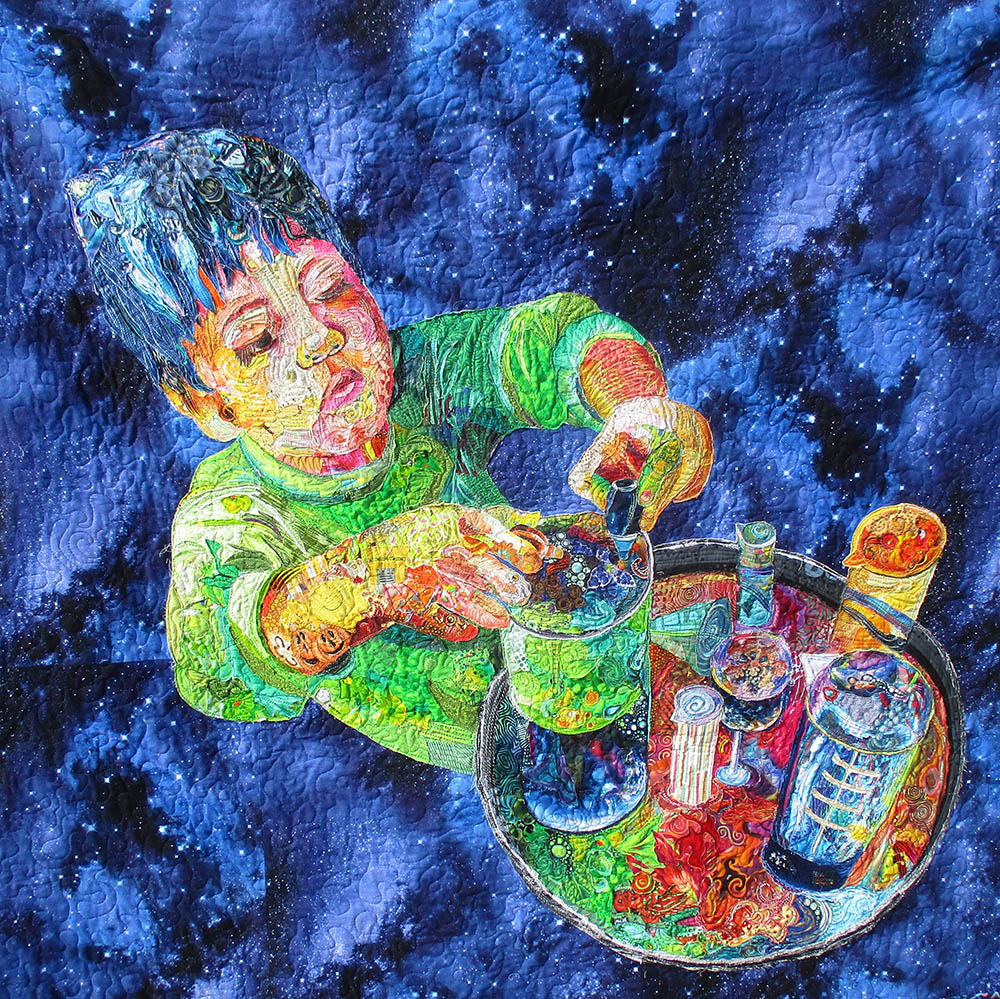
Misty Cole, from Bowie, MD, attended my October 2018 retreat here in Harpswell, Maine, with her sister Lorna Millen (whose quilt will appear in a future Finish Line post).
Misty’s quilt is based on a photo of her son. She did something I often recommend, which was turning her original color photo into black and white—helping to focus attention to the value (lights and darks) in the image rather than just the color. The change in value is a big part in creating the illusion of form and depth in a two-dimensional image.
Above and below are the photos from the Harpswell Retreat. Even in this “messy scary” stage, you can see Misty’s son emerge. What impresses me is the use of prints and novelty fabrics in this portrait. She has worked so many fun, fanciful, and kid-like prints into his face and arms—while still maintaining realism and a smooth transition of light to dark values. That rich collage of images from the fabrics also tells us something about this kid who is so intent on his science project.
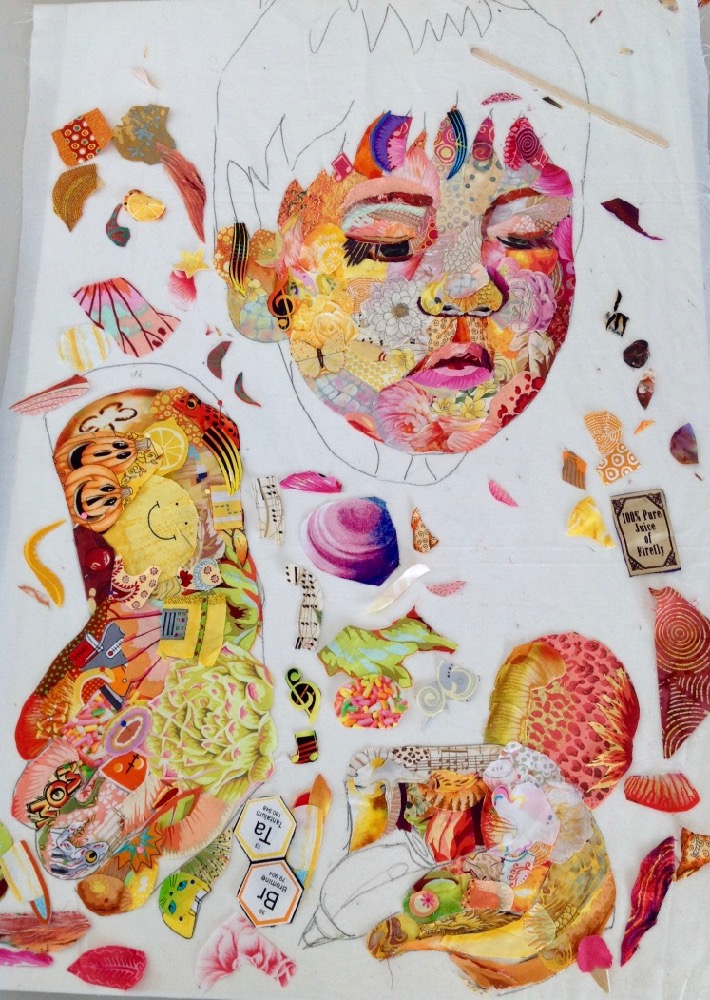
Seeing the quilt finished is a treat—I love the swirling ingredients on the tray, and the background is appropriate for this budding scientist.
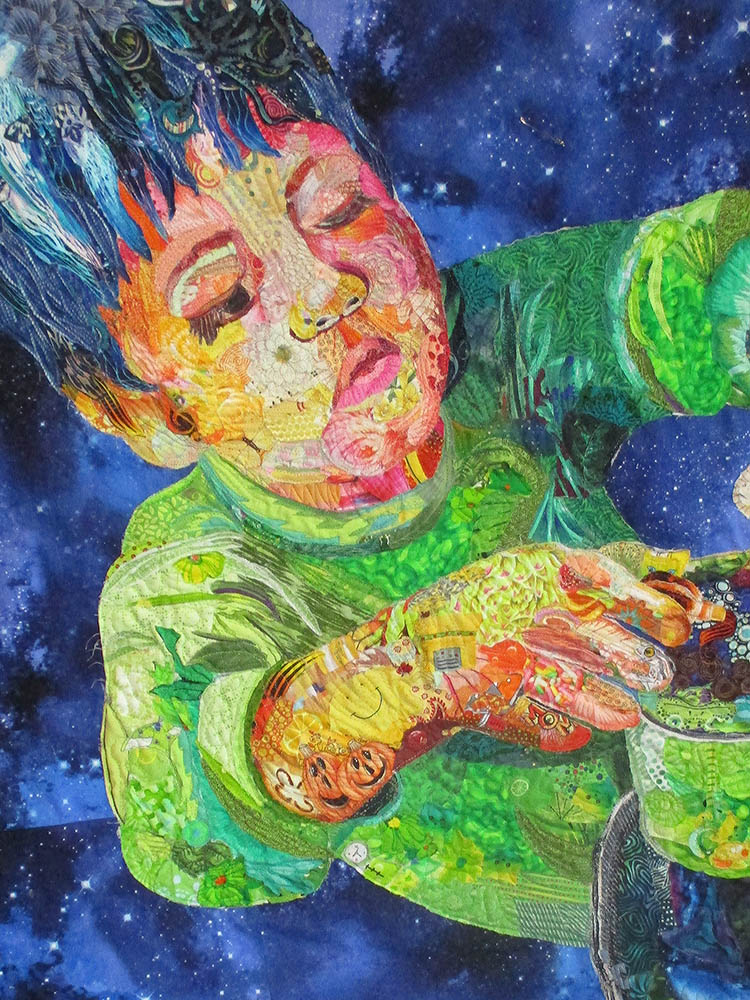
From Misty:
Completed at home. It won several awards including Member’s Choice (best of show) at my local quilt guild show, Southern Comforters Quilt Guild of Bowie.
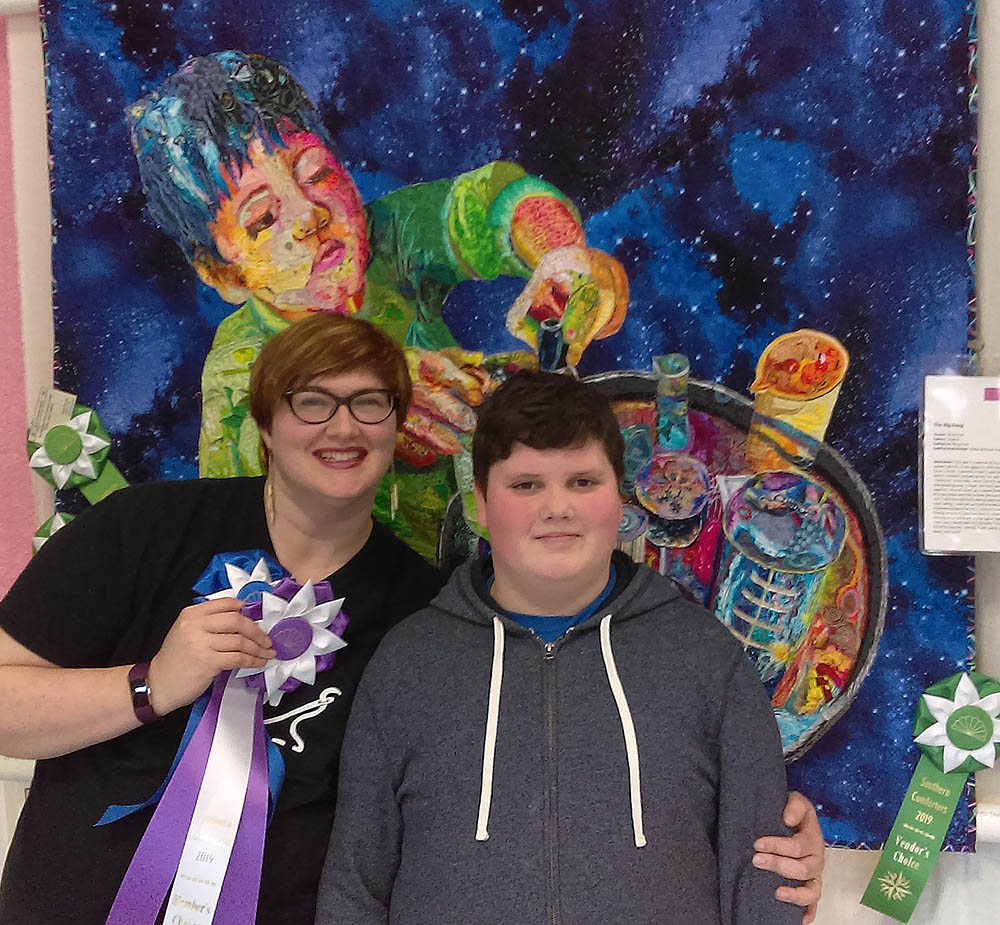
* * *
Judy Lyon
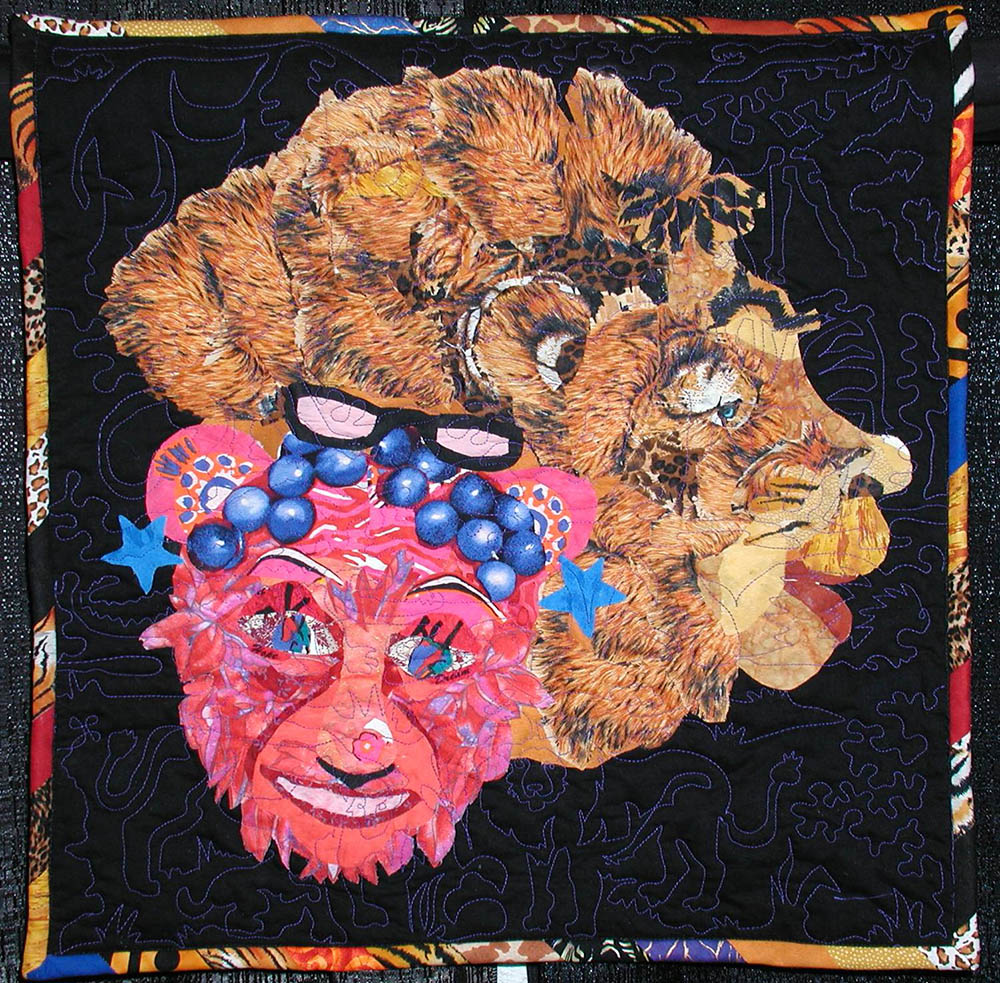
This playful self-portrait quilt was created by Judy Lyon of Lansing, Kansas. After viewing a program, “… showing quilt pictures created by gluing on bits of fabric,” She decided she had to try the method, sure the impressionist style would be fun to try.
When I received a guild challenge to create a self-portrait, I was hesitant to try to make a true likeness of myself. Since we are Lyons it seemed natural to fashion a self-portrait from the animal kingdom. My husband is the real lion. I studied his profile to give the lion his likeness. I am the lioness. I added touches that would reflect the “real” me. For example, my glasses are always on top of my head and I often wear a pair of star shaped earrings. I love red. In fact, that was even my mother’s maiden name, so our portrait has another layer of significance.
Judy is a long-arm quilter and used her own “Safari 6” pictogram design with a contrasting color thread to highlight the stitched design. A very nice way to tie the solid background into the African animal subject matter.
* * *
Deborah Black
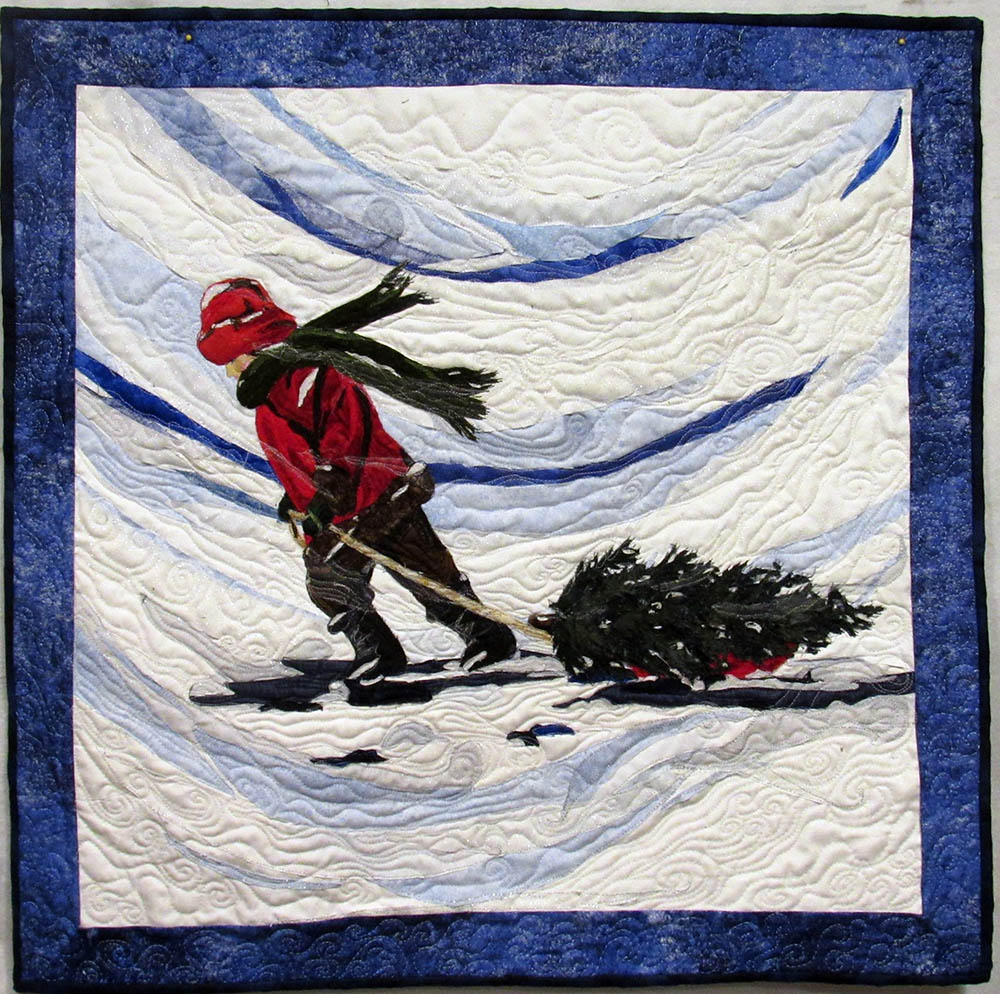
Deborah Black of Lexington Township in the great state of Maine sent in this quilt, whose subject has Maine written all over it—especially for this time of year. The figure itself is not that large, but Deborah got some good details in nevertheless (the smaller the image, the harder that is to do). In the finished detail below, you can see the strips of glittered tulle that she placed into the background. That and the quilted swirls of wind, really add to the frosty-ness of this quilt.
From Deborah:
My first introduction to fabric collage was creating the sun and moon hangings from the Serendipity Quilts book. I love color and design and enjoy the process of actually painting with fabric. Occasionally I like to combine methods, using traditional piecing for borders and sometimes backgrounds to enhance the art quilt. I also enjoy free motion quilting to finish it off. I’ve worked on 8 different hangings. The projects that I’ve done have used Susan’s method of building the quilt, (although I free hand draw the subjects instead of using a photo copy). I still find it hard to “let loose”, but it’s fun to try.
My mother would send lovely Christmas cards each year, one like this being a favorite of mine. As children we would trudge through deep snow looking for the perfect tree. She always liked the first one we saw, closest to the car. Most years the tree that came home with us was the farthest from the car, but she was a good sport about it. After she passed away, this was a way to still feel close to her.
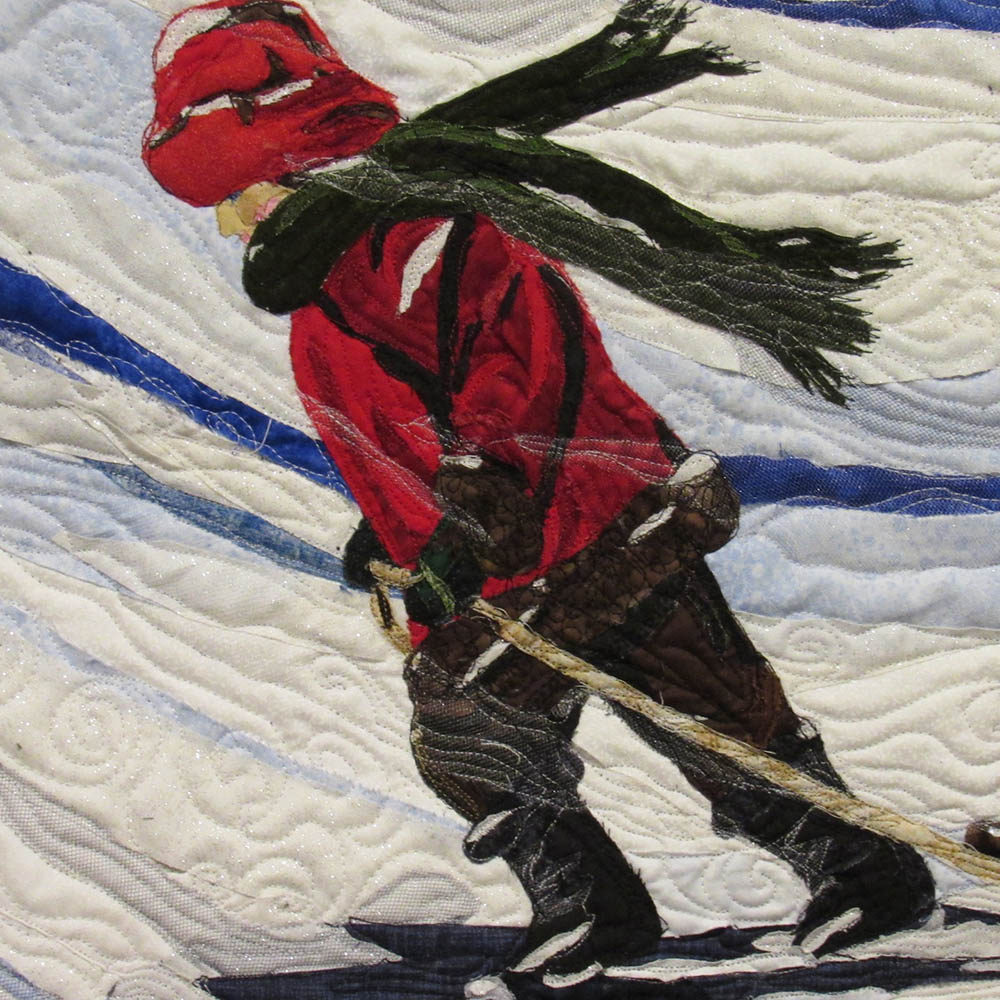
* * *
Ellen Parrott
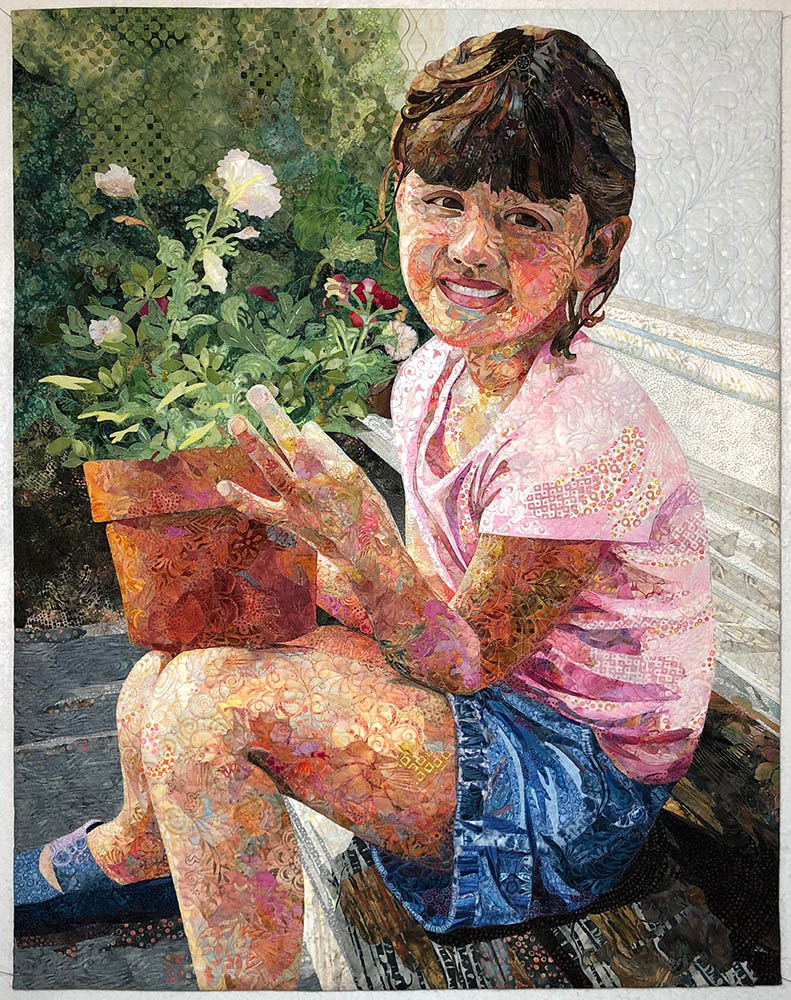
From Dansville, Michigan, Ellen Parrott’s experience as an artist shows clearly in this amazing quilt of the little girl next door. Ellen points out that I don’t usually recommend portraits as beginning subject matter for my classes, which is true, since most students approach my fabric collage classes with a quilting background, not an art background. In the class Ellen took from me, I soon could see that Ellen was clearly not a novice artist. Seeing this finished quilt, I was “gobsmacked“—a very appropriate reaction and a favorite expression introduced to me by my Australian friends.
Ellen used this fabric collage technique to it’s max—color, value, and a masterful use of fabric prints to create visual texture and contours—a feast for the eyes. Beautiful.
From Ellen:
I started this quilt at a Woodland Ridge retreat in April 2017. I had read Serendipity Quilts many years before and was completely inspired to transfer my love for painting and drawing portraits of children to this new medium. Working from a photograph I’d taken of the little girl next door, I made my first ever collage quilt [below]. I found working with fabric as my ‘paint’ to be freeing and exhilarating but obviously had a lot to learn.
Over the years I took classes from other well known quilt artists, learned various techniques, and developed a certain comfort with what was working for me. Then the opportunity arose to attend a workshop led by Susan, whose work I continued to admire, and I couldn’t let it pass! I revisited the theme of that same little neighbor girl from all those years before and “Flower Girl” was the happy result.
Flower Girl was originally begun as a watercolor painting [below] that I never finished after my then toddler grandson took a colored pencil to it. Argh! The image stayed with me though, and I knew that someday she would come to life.
I know Susan sometimes discourages portraits as subject matter, but I felt that her workshop was the perfect time to revisit this sunny girl. In class it was a little hard to let go of familiar ways of working, but I thoroughly enjoyed learning to see fabric in new ways, small tips from Susan that opened my eyes to better results, and the camaraderie of women creating together and having fun. I might have been quiet in class but I was having a great time!
After the retreat there were still many, many hours (months) of work until ‘Flower Girl’ was finished but she finally was and subsequently was exhibited at both Houston in 2018 and Spring Paducah in 2019. I love the full circle feeling of knowing that the very first collage quilt I ever made was of this same young girl and also inspired by Susan’s work.
And by the way . . . that toddler grandson, Chase, is now 13 years old and asked me if he could learn to make a quilt “like that.” He can and he did!
Wow, the talent seems to run in the family—Chase looks to be following in his grandmother’s footsteps—very impressive, Chase!
* * *
Celeste Poulin

Celeste Poulin from Sidney, Maine attended a short one-day workshop I taught for Art Quilts Maine this past summer. I don’t normally teach one-day classes, but the group suggested the intriguing idea of doing a fabric collage eye workshop. Since it was close to home in Augusta, Maine, I agreed. This quilt is based on the pattern I provided in class. You may recognize this face, as it is based not only on my “Eye for an Eye” demo, but also on the face design for “Monarch Maia.”
The intent of the class was to concentrate on—to really look at and understand the structure—of a single feature of the face. The ladies did a great job and have inspired me to consider a series of one-day “facial feature” workshops in the future. Celeste took the class eye project a bit farther and completed the entire cropped design on her own, with a lovely result. Nice use of values, Celeste.
From Celeste:
I had been intrigued by eyes and have wanted to learn more about making them since I started art quilting two years ago. I completed my eye in class using the sketch and a photo that she provided of part of her niece’s face as a guide. Susan had also given us some great tips for other facial features, so after completing my eye in class, I decided to try to collage the rest of the partial face. I wanted a face for my eye to “rest.” I read Serendipity Quilts as I was making this and it definitely helped make collage quilting “click” in my mind.
This little quilt has inspired me to want to try more collage quilting using Susan’s technique. I enjoyed making this so much that I purchased the “pelican” appliqué scissors and can’t wait to make a quilt with them. The sun in Serendipity Quilts looks like fun!
* * *
Kelly Stockwell
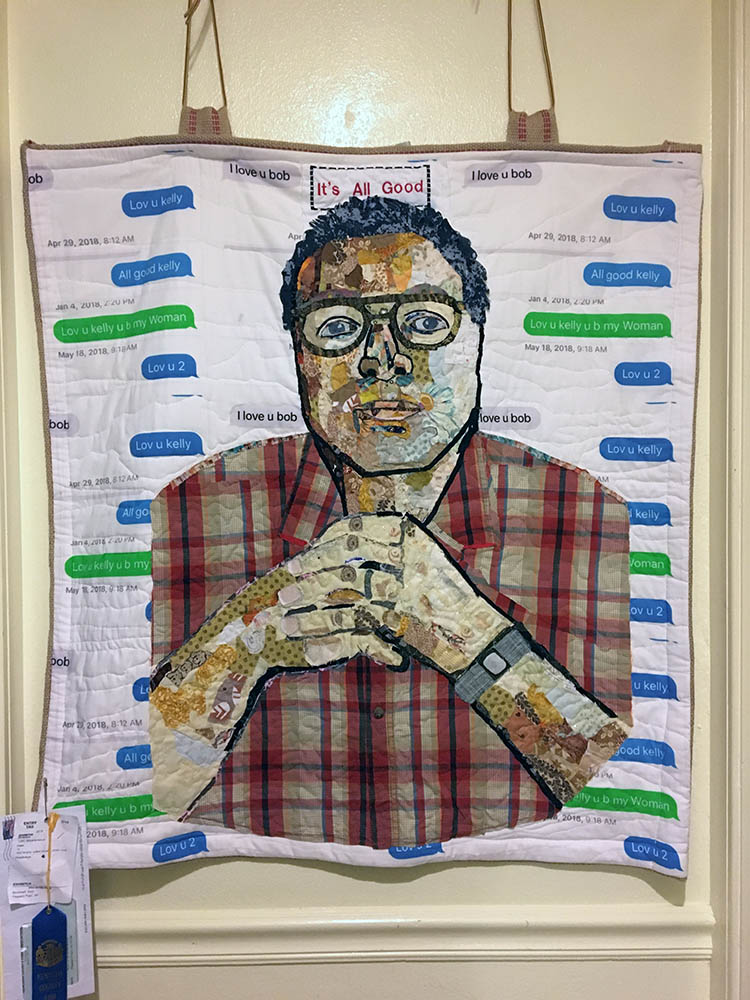
Kelly Stockwell of Beach Park, Illinois, is a member of the Online Fabric Collage Master Class and also owns my book Serendipity Quilts. This touching piece was her very first fabric collage quilt. Amazing. This is truly an impressionistic piece—look closely and it’s very abstract, but when you back up, it all comes together into a recognizable portrait. Very nice treatment of values as well. The story Kelly and her quilt tell is tissue-worthy, so have some Kleenex on hand.
This is my husband Bob. He died May 26, 2018 and for the next year I grieved so I wanted to do something really special for the anniversary of his one year that he died. So I made this collage quilt. It was in so many ways healing and comforting. The shirt is his and the background fabric is mine and his texts to each other. I didn’t do the best but I did it and that’s what was so healing. He always would say… “It’s all Good Kelly” so that’s what I named it… the “It’s All Good” collage quilt.
I know I jumped into a BIG project first thing. I also realize that I have A LOT to learn but with this year of grief and healing I wanted to do this for me. I was being very selfish. Now I am going back to the very beginning and starting the Master Class all over (with the spiral!!!). I am very proud however, that I was able to complete this and it did win 1st place in the local fair in its class.
Thank you for your consideration and the entire blog, classes, and free info you give to us on a daily basis. You are truly an inspiration.
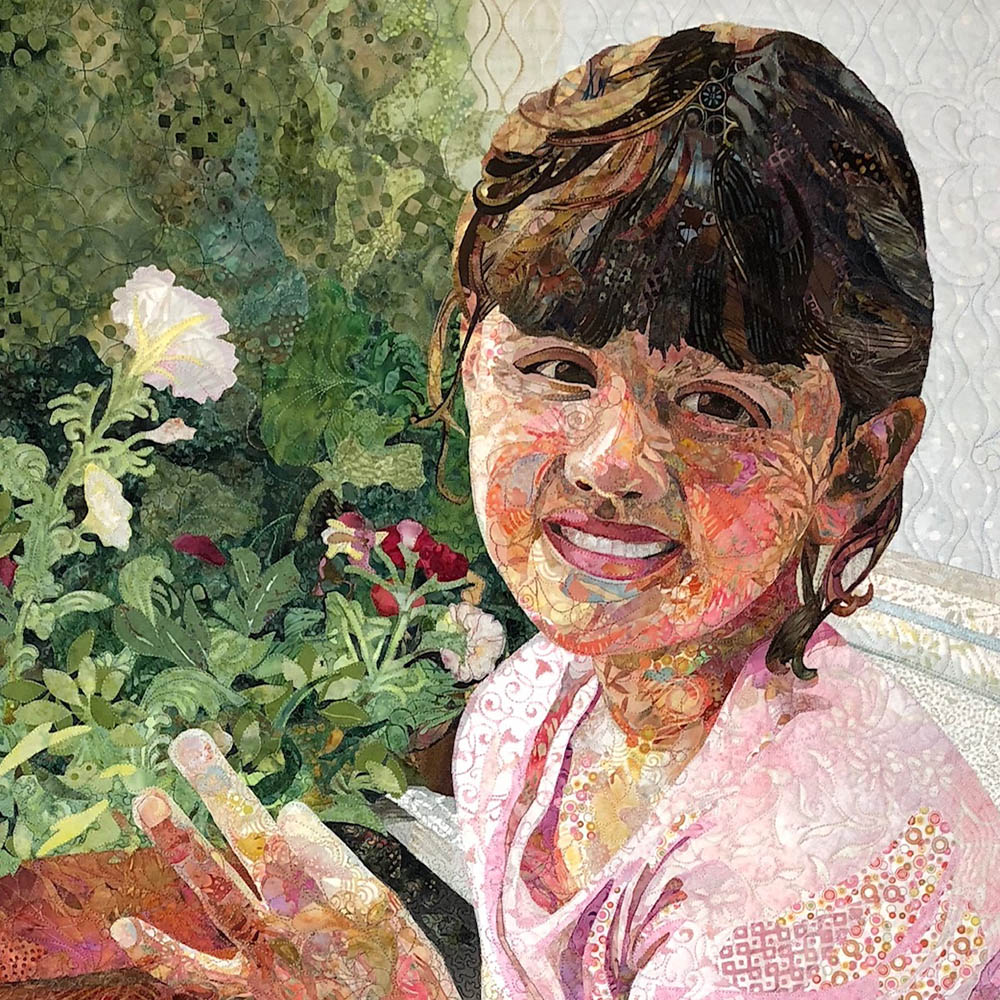






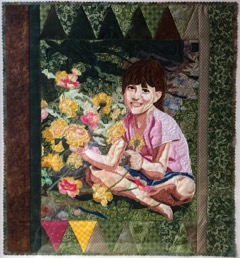
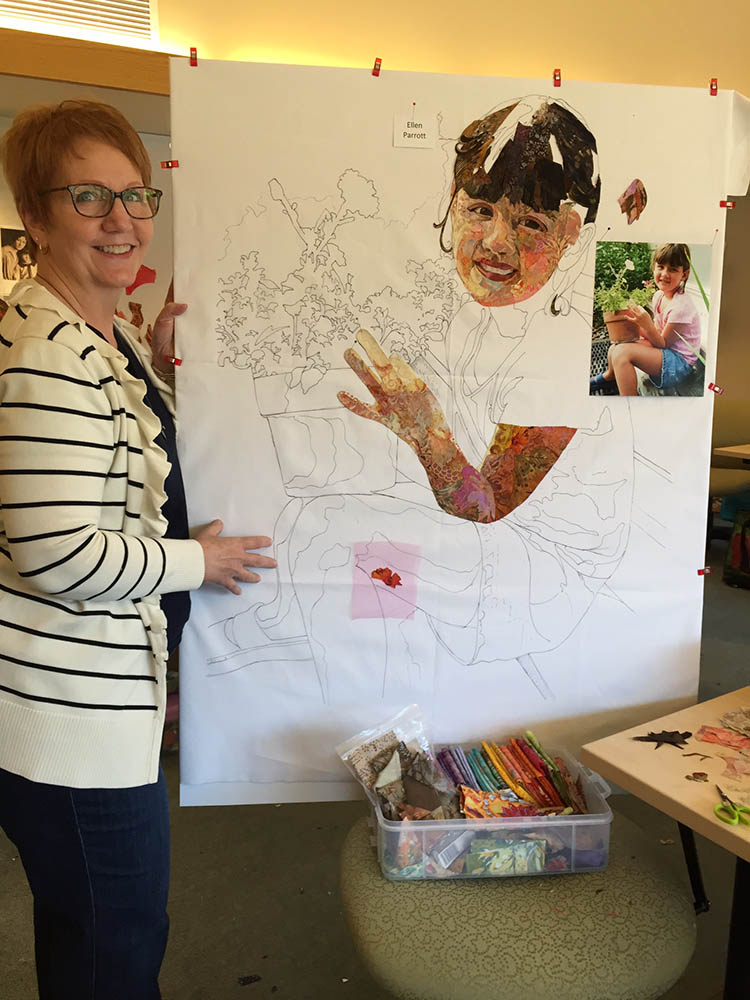
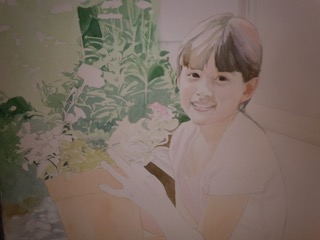














All the portraits are wonderful. I suppose, by definition, portraits are supposed to be “real.”
What I love about Bob is that Kelly took Susan’s approach but transformed it into her own style. Bob is a bold and real and intimate statement and isn’t that what art is all about?
These portraits are amazing! I’m not brave enough to go there yet, (animals are a little less critical!!), but these artists sure have done you proud, Susan! Bravo!
Most human portraits I’ve seen are awkward looking. I find I can’t even look at them, as they give me the creeps! Ha! I know it’s a loving, creative thing to do, but sometimes it just doesn’t work,… for me. These portraits, however, are so creative and executed so well, that I find myself looking closer to see the detail and how it was accomplished. They are pleasing pieces to look at and heart warming too.
I truly loved these portrait quilts. Ellen Parrott, you are a MASTER! I loved every little thing about your Flower Girl.
Every one of these quilts are wonderful. My hubby thought the Flower Girl was a painting when first viewed. And I was moved by “It’s All Goodâ€. You are inspiring Susan girl!
I’m just starting the online Master Class and I’m so inspired by these portraits and the
Story behind each one. I love the use of color and the attention to the fine detail in each photograph and then the choice of fabric used. It’s such a beautiful technique that Susan has developed. Thanks to each of you for sharing your art.